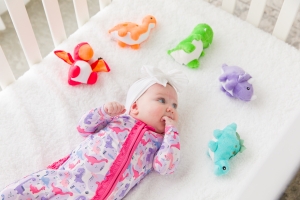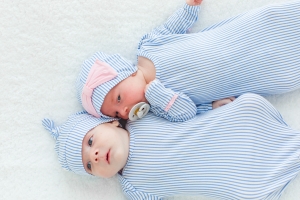UPF vs SPF: What’s the Difference?
UPF vs SPF: What’s the Difference?
Whether you’re scanning the tide pools for all sorts of wriggly sea creatures or picnicking at the park, there are plenty of activities to dive into when the sun’s rays are on the rise. But when the sun is out, coverage is in—especially on your little honey bun.
Whether it’s sunscreen or protective clothing, you’ll want to be sure you’re keeping your little one’s sun-sensitive skin safe and sound.
That’s why it’s helpful to know the difference between UPF and SPF.
UPF measures the protective value of fabric, while SPF indicates how much protection is offered from products like sunscreen, lip balm, concealer, and more.
If SPF and UPF have still got you scratching your head, we’re here with a ray of guidance to help you understand the difference between the two, what the numbers in SPF and UPF indicate, and how to choose quality UPF baby girl swimsuits. Read on as we take on the murky ins and outs of sun protection and make them as clear as a sunny day.
Understanding UV Light
Understanding UV Light
First up, let’s put ultraviolet light under the microscope. Ultraviolet light makes up about 10% of the sun’s radiation and comes in three forms:
- UVA – All UVA radiation reaches the earth.
- UVB – Some UVB radiation reaches the earth, but a portion of it is often absorbed by the ozone layer.
- UVC – All UVC radiation is absorbed by the ozone layer.
So, when you’re dressing up your little doll for a Saturday in the sand or a Monday in the mountains, you’ll need to be on the lookout for UVA and UVB rays—not UVC. While UV light does aid in the body’s production of vitamin D, both UVA and UVB rays can do more harm than good.
The good news is that you’ve got two excellent options to keep your little one in good hands: UPF and SPF.
What is SPF Protection?
You’ve seen it on sunscreen, lotion, chapstick, conditioner, and even eyeshadow. But what exactly does SPF mean?
Simply put, SPF stands for sun protection factor.
Regulated by the United States Food and Drug Administration (FDA), it’s a measure of how much solar radiation (specifically UVB radiation) is required to cause a sunburn on protected skin versus unprotected skin.
The acronym SPF is always followed by a number indicating how protective the product is. Contrary to common belief, SPF numbers don’t have to do with sun exposure time but the amount of exposure.
For example:
- SPF 15 blocks about 93% of the sun’s rays
- SPF 30 blocks about 96% of the sun’s rays
- SPF 45blocks about 97.8% of the sun’s rays
- SPF 50 blocks about 98% of the sun’s rays
To put it in simpler terms of protection:
- SPF below 15 – Low protection
- SPF between 15 and 29 – Medium protection
- SPF between 30 and 49 – High protection
- SPF over 50 – Very high protection
Although the time of exposure and amount of UV radiation absorbed do go hand-in-hand, it’s important to remember that you get more UV exposure from the sun at midday than you do from the sun in the early morning or evening.
Some other factors that impact how much solar radiation is absorbed are:
- Cloud coverage
- Latitude
- Elevation
- Skin pigmentation
Because so many different, fluctuating, and individual factors impact the efficacy of sunscreen, SPF is a relative measure and may vary from product to product. Plus, not all sunscreens offer broad-spectrum protection. In other words, they won’t protect against both UVA and UVB rays unless they’re classified as “broad spectrum” on the label.
What is UPF Protection?
While sunscreen is rated using the SPF system, clothing is rated using the ultraviolet protection factor (UPF) system. UPF is a measure of the amount of total UV radiation (both UVA and UVB) that can penetrate the fabric to reach the skin beneath.
You might be asking yourself what is UPF 50 and what kind of protection does it offer?
Like SPF sunscreens, UPF clothing is rated numerically. Some common UPF ratings that you might come across are:
- UPF 30 – This blocks about 96% of the sun’s UVA and UVB rays
- UPF 50 – This blocks about 98% of the sun’s UVA and UVB rays
But what is UPF clothing exactly? Unlike SPF lotions and creams, clothing doesn’t need to have a UPF factor to be sun protective. In fact, all clothing offers UPF protection.
The factors that typically determine a fabric’s protection are:
- Weave – Denser woven fabrics are more protective than more loosely woven fabrics
- Color – Darker fabrics are more protective than lighter fabrics
- Textile – Polyester and nylon offer more protection than natural fabrics
So, even your everyday clothing offers a level of UPF. For example, a white t-shirt might offer 10 UPF, whereas a dark denim jacket or jeans provides 1700 UPF.
Comparing SPF and UPF
Now that you’ve gained a deeper understanding of the two, you might be wondering—which is better: SPF or UPF? The answer is neither. The best sun protection for you and your little one comes from combining SPF and UPF products.
Together they form an effective shield from the sun, but there are a few pros and cons to both sunscreen and sun-protective clothing:
- UV protection – SPF may offer only UVB protection, while UPF offers both UVA and UVB protection.
- Ease of use – Depending on the part of the body needing coverage, sunscreen might be easier (on the face and hands, for example) or sun clothing might be more convenient (on the arms and torso). Using a combination of sunscreen and sun clothing is the surest way to get the top level of protection all day long.
- Decreased efficacy over time – While sunscreen and SPF products wear off after about two hours (without swimming or sweating) and need to be reapplied, UPF clothing protection does not diminish with time and use.
There isn’t one right way to protect yourself and your little one from the sun. By combining the power of SPF sunscreen with the power of UPF clothing, you’ll be able to mix and match what feels right to you. Try some variation on this top-down scheme to keep them perfectly protected:
- Sun hat
- Sunscreen on their face
- High-neck long-sleeve rash guard over a swimsuit or swim trunks
- Sunscreen on their hands
- Sunscreen on their legs and feet
UPF Clothing to Pack for Sun-Filled Adventures
Sun protective clothing is a great way to ensure you're limiting the UV rays hitting the skin during sun exposure. Instead of packing heavy, densely woven denim on your warm-weather adventures, we’ve put together a list of UPF rated clothing essentials that are jst as lightweight and protective as they are comfortable:
- Long sleeve rash guard bikini – If your sun-soaked escapades take you to the beach, lake, or pool, you’ll want to pack along this rash guard bikini. It offers UPF 50+ protection, an assortment of adorable patterns, and our signature ruffles on the rear. If you're wondering, "what is a rash guard?", it's a great type of sun protective clothing that can limit harmful UV rays and protect the skin.
- Color block swim trunks – These mint and blue shorts feature UPF 50+. Plus, the interior mesh lining will keep them comfy and dry, while the stretchy waistband will make it easy to slip from swimwear to sleepwear after a long day of splashing.
- Swim hat – Whether your little one is a water baby or prefers to watch their big sibling hop the waves instead, they’ll need this UPF 50+ swim hat. A kids sun hat is one of the most essential swimming accessories for kids as It’ll keep the sensitive skin of their face shielded from the sun while rounding out any beach outfit in style. Its functional ties keep it from blowing away on a breezy day. Plus, you can even add a monogram for a personalized touch.
UPF clothes can be considered beach essentials for toddlers, older kids, and the whole family in general.
How to Care for UPF Clothing
Once you’ve committed to purchasing and using UPF clothing for yourself and your family, you’ll need to understand how to care for these garments in order to keep them in top condition.
Washing UPF clothing is a matter of treating them as you would any other specialty or delicate fabric. Follow these steps to keep them fresh and like-new:
- Always wash and rinse in cold water after every use
- Ideally handwash, but if machine-washing, use the gentle cycle
- Use a no-dye biodegradable detergent formulated for delicate fabrics or sensitive skin
- Do not wring, twist, or squeeze
- Lay flat to dry
- Do not machine dry
- Dry out of direct sunlight
Once your UPF clothing is completely dry, you can store it by gently folding or rolling it. Do not iron UPF clothing as the heat can damage the fibers of the fabric.
RuffleButts—Where Sun Protection Meets Style
Your child is the center of your universe and keeping them safe from the damaging effects of the sun is an absolute priority.
At RuffleButts, we respect that. We want to make your job just a little bit easier by offering you UPF clothing for your baby or child that’s sure to keep them sun-safe all season. We’ve designed everything from short and long-sleeved boys rash guards and girls rash guards, as well as swimwear, swim hats and rompers.
Choose safety and style for your sweet one. Shop RuffleButts today.
Sources:
United States Food and Drug Administration (FDA). Sun Protection Factor (SPF). https://www.fda.gov/about-fda/center-drug-evaluation-and-research-cder/sun-protection-factor-spf#:~:text=SPF%20is%20a%20measure%20of,value%20increases%2C%20sunburn%20protection%20increases.
Skin Cancer Foundation. Sun Protective Clothing. https://www.skincancer.org/skin-cancer-prevention/sun-protection/sun-protective-clothing/#:~:text=Ultraviolet%20Protection%20Factor%20(UPF)%20indicates,reducing%20your%20exposure%20risk%20significantly.
Cancers of the Skin Conference Paper. Role of Clothes in Sun Protection. https://link.springer.com/chapter/10.1007/978-3-642-59410-6_3
University of Calgary. Energy Education: Sunlight. https://energyeducation.ca/encyclopedia/Sunlight
Centers for Disease Control. UV Radiation. https://www.cdc.gov/nceh/features/uv-radiation-safety/index.html
Verywell Health. Sun Protection Factor (SPF) and Sunscreen.
https://www.verywellhealth.com/spf-sun-protection-factor-and-sunscreen-2634104
Environmental Working Group. Out all day? Wear a loud shirt.
https://www.ewg.org/sunsafety/tips-sun-clothing.php









